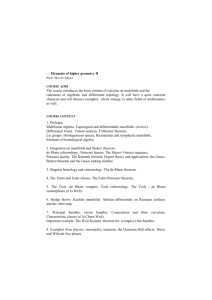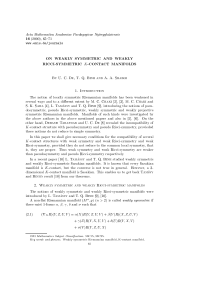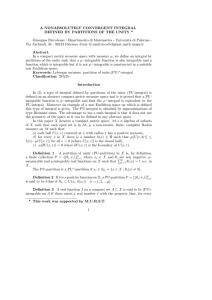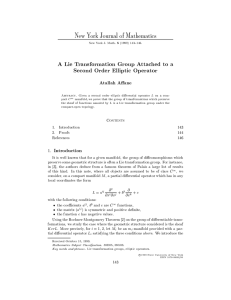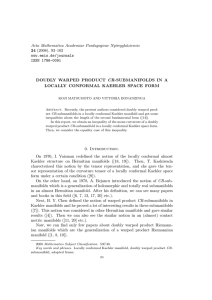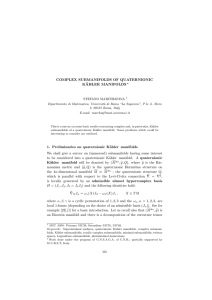NORMAL ANTI-INVARIANT SUBMANIFOLDS OF PARAQUATERNIONIC KÄHLER MANIFOLDS Novac-Claudiu Chiriac
advertisement
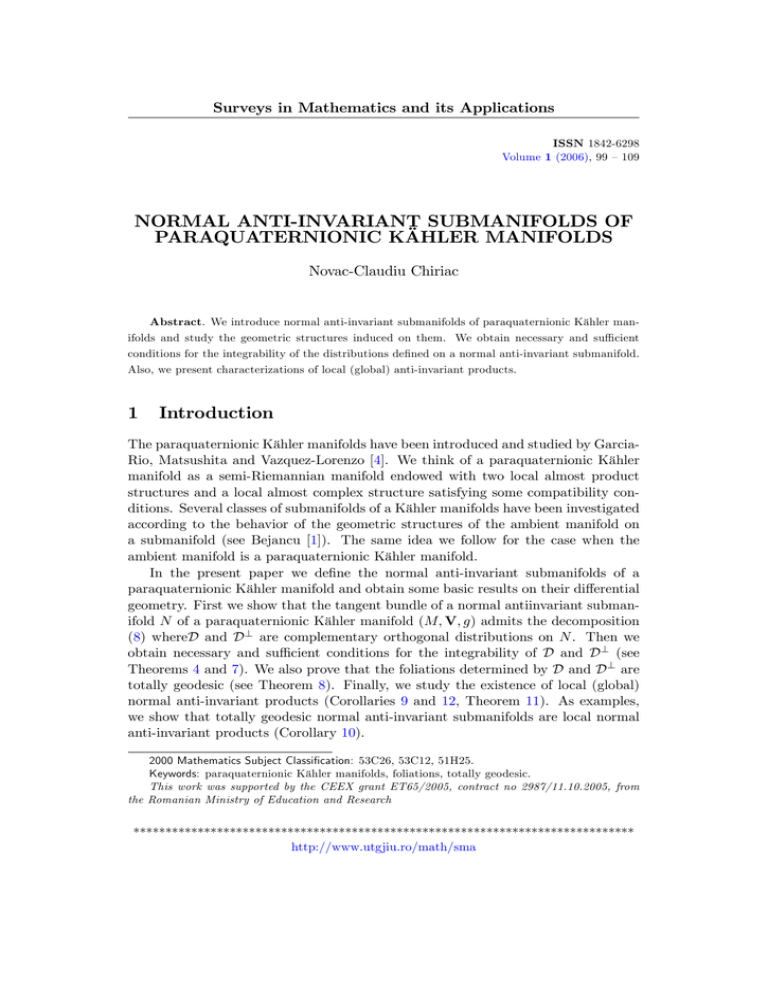
Surveys in Mathematics and its Applications ISSN 1842-6298 Volume 1 (2006), 99 – 109 NORMAL ANTI-INVARIANT SUBMANIFOLDS OF PARAQUATERNIONIC KÄHLER MANIFOLDS Novac-Claudiu Chiriac Abstract. We introduce normal anti-invariant submanifolds of paraquaternionic Kähler manifolds and study the geometric structures induced on them. We obtain necessary and su¢ cient conditions for the integrability of the distributions de…ned on a normal anti-invariant submanifold. Also, we present characterizations of local (global) anti-invariant products. 1 Introduction The paraquaternionic Kähler manifolds have been introduced and studied by GarciaRio, Matsushita and Vazquez-Lorenzo [4]. We think of a paraquaternionic Kähler manifold as a semi-Riemannian manifold endowed with two local almost product structures and a local almost complex structure satisfying some compatibility conditions. Several classes of submanifolds of a Kähler manifolds have been investigated according to the behavior of the geometric structures of the ambient manifold on a submanifold (see Bejancu [1]). The same idea we follow for the case when the ambient manifold is a paraquaternionic Kähler manifold. In the present paper we de…ne the normal anti-invariant submanifolds of a paraquaternionic Kähler manifold and obtain some basic results on their di¤erential geometry. First we show that the tangent bundle of a normal antiinvariant submanifold N of a paraquaternionic Kähler manifold (M; V; g) admits the decomposition (8) whereD and D? are complementary orthogonal distributions on N . Then we obtain necessary and su¢ cient conditions for the integrability of D and D? (see Theorems 4 and 7). We also prove that the foliations determined by D and D? are totally geodesic (see Theorem 8). Finally, we study the existence of local (global) normal anti-invariant products (Corollaries 9 and 12, Theorem 11). As examples, we show that totally geodesic normal anti-invariant submanifolds are local normal anti-invariant products (Corollary 10). 2000 Mathematics Subject Classi…cation: 53C26, 53C12, 51H25. Keywords: paraquaternionic Kähler manifolds, foliations, totally geodesic. This work was supported by the CEEX grant ET65/2005, contract no 2987/11.10.2005, from the Romanian Ministry of Education and Research ****************************************************************************** http://www.utgjiu.ro/math/sma 100 2 Novac-Claudiu Chiriac Preliminaries Throughout the paper all manifolds are smooth and paracompact. If M is a smooth manifold then we denote by F (M ) the algebra of smooth functions on M and by (T M ) the F (M )-module of smooth sections of the tangent bundleT M of M . Similar notations will be used for any other manifold or vector bundle. If not stated otherwise, we use indices: a; b; c; ::: 2 f1; 2; 3g and i; j; k; ::: 2 f1; :::; ng. Let M be a manifold endowed with a paraquaternionic structure V, that is, V is a rank-3 subbundle of End(T M ) which has a local basis fJ1 ; J2 ; J3 g on a coordinate neighborhood U M satisfying (see Garcia-Rio-Matsushita-Vazquez-Lorenzo [4]) (a) Ja2 = (b) J1 J2 = (c) 1 a I, = 2 a 2 f1; 2; 3g , (1) J2 J1 = J3 , = 3 = 1. A semi-Riemannian metric g on M is said to be adapted to the paraquaternionic structure V if it satis…es g(X; Y ) + a g(Ja X; Ja Y ) = 0; 8a 2 f1; 2; 3g; (2) for any X; Y 2 (T M ) , and any local basis J1 , J2 , J3 of V. From relation1 and relation2 it follows that g(Ja X; Y ) + g(X; Ja Y ) = 0; 8X; Y 2 (T M ); a 2 f1; 2; 3g: Now, suppose fJ~1 ; J~2 ; J~3 g is a local basis of V on U~ we have 3 X Aab Jb , J~a = (3) e 6= ;. Then M and U \ U (4) b=1 where the 3 3 matrix [Aab ] is an element of the pseudo-orthogonal group SO(2; 1). From 1 and 2 it follows that M is of dimension 4m and g is of neutral signature (2m; 2m). ~ the Levi-Civita connection on (M; g). Then the triple Next, we denote by r (M; V; g)is called a paraquaternionic Kähler manifold if V is a parallel bundle with ~ This means that for any local basis fJ1 ; J2 ; J3 g of V on U M there respect to r. exist the 1-forms p, q, r on U such that (cf. Garcia-Rio-Matsushita-Vazquez-Lorenzo [4]) (a) (b) (c) ~ X J1 )Y (r ~ X J2 )Y (r ~ X J3 )Y (r = q(X)J2 Y r(X)J3 Y; = q(X)J1 Y p(X)J3 Y , = r(X)J1 Y p(X)J2 Y ; 8X; Y 2 (T U): (5) ****************************************************************************** Surveys in Mathematics and its Applications 1 (2006), 99 –109 http://www.utgjiu.ro/math/sma 101 Submanifolds of Paraquaternionic Kähler Manifolds Now, we consider a non-degenerate submanifold N of (M; V; g) of codimension n. Then we say that N is a normal anti-invariant submanifold of (M; V; g) if the normal bundle T N ? of N is anti-invariant with respect to any local basis fJ1 ; J2 ; J3 g of V on U, that is, we have Ja (Tx N ? ) Tx N; 8a 2 f1; 2; 3g; x 2 U = U \ N: (6) A large class of normal anti-invariant submanifolds is given in the next proposition. Proposition 1. Any non-degenerate real hypersurface N of (M; g) is a normal anti-invariant submanifold of (M; V; g). Proof. From 3 we deduce that g(Ja U; U ) = 0, for any U 2 (T N ? ) and a 2 f1; 2; 3g. Hence Ja U 2 (T N ) , which proves 6. Next, we examine the structures that are induced on the tangent bundle of a normal anti-invariant submanifold N of (M; V; g) . First, we put Dax = Ja Tx N ? and note that D1x ,D2x and D3x are mutually orthogonal nondegenerate n-dimensional vector subspaces of Tx N , for any x 2 N . Indeed, by using 3, (1b) and 6 we obtain g (J1 X; J2 Y ) = g (X; J1 J2 Y ) = g (X; J3 Y ) = 0; 8X; Y 2 (T N ? ), which shows that D1x and D2x are orthogonal. By a similar reason we conclude that Dax and Dbx are orthogonal for any a 6= b. Then we can state the following. Proposition 2. Let N be a normal anti-invariant submanifold of (M; V; g) of codimension n. Then we have the assertions: (i) The subspaces Dax of Tx N satisfy the following Ja (Dax ) = Tx N ? and Ja (Dbx ) = Dcx , for any x 2 U , a 2 f1; 2; 3g, and any permutation (a; b; c) of (1; 2; 3). (ii) The mapping D? : x 2 N ! Dx? = D1x D2x D3x ; de…nes a non-degenerate distribution of rank 3n on N . (iii) The complementary orthogonal distribution D to D? in T N is invariant with respect to the paraquaternionic structureV, that is, we have Ja (Dx ) = Dx ; 8x 2 U ; a 2 f1; 2; 3g : ****************************************************************************** Surveys in Mathematics and its Applications 1 (2006), 99 –109 http://www.utgjiu.ro/math/sma 102 Novac-Claudiu Chiriac Proof. First, by using 1 we obtain the assertion (i). Next, by 4 and taking into account that Ja , a 2 f1; 2; 3g, are automorphisms of (T M ) and Dax , a 2 f1; 2; 3g are mutually orthogonal subspaces we get the assertion (ii). Now, we note that the tangent bundle of M along N has the following orthogonal decompositions: TN? = D TM = TN Then we take Y 2 D? T N ?: (7) D? and by the assertion (i) we deduce that D? Ja Y 2 On the other hand, if Y 2 T N ? ; 8a 2 f1; 2; 3g : T N ? , by 6 and the assertion (ii) we infer that D? ; 8a 2 f1; 2; 3g Ja Y 2 Thus by using 3 and the second equality in 7 we obtain g (Ja X; Y ) = g (X; Ja Y ) = 0; 8a 2 f1; 2; 3g ; for any X 2 (D) and Y 2 D? T N ? . Hence Ja X 2 (D) for any a 2 f1; 2; 3g and X 2 (D) , that is, D is invariant with respect to the paraquaternionic structure V. This completes the proof of the proposition. By assertion (iii) of the above proposition we are entitled to call D the paraquaternionic distribution on N . Also, we note that the paraquaternionic distribution in non-trivial, that is D = 6 f0g, if and only if dimN > 3n. 3 Integrability of the Distributions on a Normal AntiInvariant Submanifold Let N be a normal anti-invariant submanifold of codimension n of a 4m-dimensional paraquaternionic Kähler manifold (M; V; g). Then according to the de…nitions of D and D? we have the orthogonal decomposition TN = D D? (8) Then we consider a local …eld of orthonormal frames fU1 ; :::; Un g of the normal bundle T N ? , and de…ne Eai = Ja Ui ; a 2 f1; 2; 3g ; i 2 f1; :::; ng : (9) Taking into account 6 and the assertion (ii) of Proposition 2 we deduce that fEai g ; a 2 f1; 2; 3g ; i 2 f1; :::; ng, is a local …eld of orthonormal frames of D? . Thus we can put 3 X n X X = PX + ! bi (X)Ebi ; 8X 2 TN? ; (10) b=1 i=1 ****************************************************************************** Surveys in Mathematics and its Applications 1 (2006), 99 –109 http://www.utgjiu.ro/math/sma 103 Submanifolds of Paraquaternionic Kähler Manifolds where P is the projection morphism of T N on D with respect to the decomposition 8, and ! bi are 1-forms given by ! bi (X) = "bi g (X; Ebi ) ; "bi = g (Ebi ; Ebi ) : (11) Now, we apply Ja , a 2 f1; 2; 3g to 10 and by using 9 and 1 we obtain (a) J1 X = J1 P X + (b) J1 X = J1 P X (c) J1 X = J1 P X n X i=1 n X i=1 n X i=1 f! 2i (X)E3i + ! 3i (X)E2i + ! 1i (X)Ui g ; f! 1i (X)E3i + ! 3i (X)E1i f! 1i (X)E2i ! 2i (X)Ui g ; (12) ! 2i (X)E1i + ! 3i (X)Ui g : Next, we consider the Gauss equation (cf. Chen [3]) ~ X Y = rx Y + h (X; Y ) ; r 8X; Y 2 (T N ) , (13) ~ and r are the Levi-Civita connections on (M; g) and (N; g) respectively, where r and h is the second fundamental form of N . Also, we have the Weingarten equation ~ XU = r AU X + r ? X U; 8X 2 (T N ) ; U 2 TN? , (14) where AU is the shape operator of N with respect to the normal section U , and r? is the normal connection on T N ? . Moreover, h and AU are related by g(h(X; Y ); U ) = g(AU X; Y ); 8X; Y 2 (T N ) ; U 2 TN? : (15) Proposition 3. Let N be a normal anti-invariant submanifold of a paraquaternionic Kähler manifold (M; V; g). Then we have h (X; Ja Y ) = a n X i=1 for any X; Y 2 f! ai (rX Y )Ui g ; (16) (D) and a 2 f1; 2; 3g . Proof. By direct calculations using (13) and (12a) in (5a) we deduce that rx J1 Y + h (X; J1 Y ) = J1 P (rx Y ) n X + f! 2i (rX Y )E3i + ! 3i (rX Y )E2i + ! 1i (rX Y )Ui g i=1 +J1 h (X; Y ) + q(X)J2 Y r(X)J3 Y: Then taking the normal parts in the above equality we obtain (16) for a = 1. In a similar way follows (16) for a = 2 and a = 3. ****************************************************************************** Surveys in Mathematics and its Applications 1 (2006), 99 –109 http://www.utgjiu.ro/math/sma 104 Novac-Claudiu Chiriac Now, we say that N is D-geodesic if its second fundamental form h satis…es (see Bejancu [1]) h(X; Y ) = 0; 8X; Y 2 (D) , (17) Then by using (13) and (17) we deduce that N is D-geodesic if and only if any geodesic of (N; g) passing through each x 2 N and tangent to Dx is a geodesic of (M; g). Theorem 4. Let N be a normal anti-invariant submanifold of a paraquaternionic Kähler manifold(M; V; g). Then the following assertions are equivalent: (i) The second fundamental form h of N satis…es h (X; Ja Y ) = h (Y; Ja X) ; 8X; Y 2 (D) ; a 2 f1; 2; 3g (18) (ii) N is D-geodesic. (iii) The paraquaternionic distribution D is integrable. Proof. (i) =) (ii). By using (18) and (1b) we deduce that h (J3 X; Y ) = h (X; J3 Y ) = h (X; J1 (J2 Y )) = h (J1 X; J2 Y ) = h (J2 (J1 X) ; Y ) = h (J3 X; Y ) ; 8X; Y 2 (D) which implies h (J3 X; Y ) = 0. Taking into account that J3 is an automorphism of (D) we obtain (17). Hence N is D-geodesic. (ii) =) (iii). By using (17) and (11) in (16) we infer that g (rx Y; Eai ) = 0; Hence rx Y 2 8X; Y 2 (D) ; a 2 f1; 2; 3g ; i 2 f1; :::; ng : (19) (D), which implies [X; Y ] = rx Y rY X 2 (D) Thus D is integrable. (iii) =) (i). By using (16) and (11), and taking into account that r is a torsionfree connection, we obtain h (X; Ja Y ) h (Y; Ja X) = n X i=1 for any X; Y 2 fg ([X; Y ]; Eai ) Ui g = 0; (D) and a 2 f1; 2; 3g . This completes the proof of the theorem. Proposition 5. The shape operators Ai with respect to the normal sections Ui , i 2 f1; :::; ng, satisfy the identities: Ai Eaj = Aj Eai ; 8a 2 f1; 2; 3g ; i; j 2 f1; :::; ng : (20) ****************************************************************************** Surveys in Mathematics and its Applications 1 (2006), 99 –109 http://www.utgjiu.ro/math/sma 105 Submanifolds of Paraquaternionic Kähler Manifolds Proof. We take X 2 (1) we obtain (T N ) and Y = E1i in (5a) and by using (13), (14), (9) and Ai X + r? X Ui = J1 (rX E1i ) + J1 h(X; E1i ) q(X)E3i + r(X)E2i : Then by using (15), (2), (9) and the above equality we deduce that g (Aj E1i ; X) = g (h (X; E1i ) ; Uj ) = g (J1 h (X; E1i ) ; E1j ) = g (Ai X + J1 (rX E1i ); E1j ) = g (Ai X; E1j ) g (rX E1i ; Uj ) = g (X; Ai E1j ) ; 8X 2 (T N ) , which proves (20) for a = 1. In a similar way we obtain (20) for a = 2 and a = 3. Next, we de…ne on (D) the 1-forms aij for any X 2 (X) = g (rEai Eaj ; X) ; (21) (D) , a 2 f1; 2; 3g and i; j 2 f1; :::; ng . Then we state the following. Proposition 6. Let N be a normal anti-invariant submanifold of a paraquaternionic Kähler manifold (M; V; g). Then we have: aij = aji ; 8a 2 f1; 2; 3g ; i; j 2 f1; :::; ng ; (22) and (a) g (rE1i E2j ; X) = (b) g (rE2i E3j ; X) = (c) g (rE3i E1j ; X) = for any X 2 1ij (J3 X) ; 2ij 3ij (J1 X) ; (J2 X) ; g rE2j E1i ; X = 2ij g rE3j E2i ; X = g rE1j E3i ; X = (J3 X) ; 3ij 1ij (J1 X) ; (J2 X) ; (23) (D) . Proof. By using (21), (9), (13), (5), (3) and (14) we obtain aij ~ E Ja Uj ; X = g Ja (r ~ E Uj ); X = (X) = g r ai ai = ~ E Uj ; Ja X = g (Aj Eai ; Ja X) ; g r ai (24) for any a 2 f1; 2; 3g and i; j 2 f1; :::; ng. Then (22) follows by using (24) and (20). Next, by using (13), (2), (5), (1), (9) and (21) we deduce that ~ E E2j ; X = g J3 r ~ E E2j ; J3 X g (rE1i E2j ; X) = g r 1i 1i ~ E E1j ; J3 X = = g r 1i 1ij (J3 X) ; 8X 2 (D) which proves the …rst equality in (23a). In a similar way are obtained all the other equalities in (23). ****************************************************************************** Surveys in Mathematics and its Applications 1 (2006), 99 –109 http://www.utgjiu.ro/math/sma 106 Novac-Claudiu Chiriac Theorem 7. Let N be a normal anti-invariant submanifold of a paraquaternionic Kähler manifold (M; V; g). Then the following assertions are equivalent: (i) The distribution D? is integrable. (ii) aij = 0, 8a 2 f1; 2; 3g ; i; j 2 f1; :::; ng. (iii) For any X 2 (D) and Y 2 D? we have h(X; Y ) = 0: (25) Proof. Taking into account that r is torsion-free, and by using (21) and (22) we deduce that g([Eai ; Eaj ]; X) = 0; 8X 2 (D) ; a 2 f1; 2; 3g ; i; j 2 f1; :::; ng : (26) On the other hand, by using (23) we obtain (a) g([E1i ; E2j ]; X) = 1ij (J3 X) + 2ij (J3 X) ; (b) g([E2i ; E3j ]; X) = 3ij (J1 X) 2ij (J1 X) ; (c) g([E3i ; E1j ]; X) = 3ij (J2 X) 1ij (J2 X) ; (27) for any X 2 (D). Then from (26) and (27) we infer that (ii) implies (i), since fEai g, a 2 f1; 2; 3g, i; j 2 f1; :::; ng is an orthonormal basis of D? . Now, we suppose that D? is integrable. Then taking into account that Ja , a 2 f1; 2; 3g, are automorphisms of (D) from (27) we deduce that aij satisfy the system 1ij + 2ij = 0; 3ij 2ij = 0; 3ij 1ij = 0: Hence aij = 0, for all a 2 f1; 2; 3g , and i; j 2 f1; :::; ng. Thus we proved that (i) implies (ii). Finally, by using (24) and (15) we obtain aij (X) = g (h (Ja X; Eai ) ; Uj ) ; for any a 2 f1; 2; 3g , and i; j 2 f1; :::; ng, which implies the equivalence of (ii) and (iii). This completes the proof of the theorem. 4 Foliations on a Normal Anti-Invariant Submanifold Let F be a foliation on (N; g). Then we say that F is totally geodesic if each leaf of F is totally geodesic immersed in (N; g). Denote by F(D) and F(D? ) the foliations determined by D and D? respectively, provided these distributions are integrable. Theorem 8. Let N be a normal anti-invariant submanifold of a paraquaternionic Kähler manifold (M; V; g). Then we have the assertions: ****************************************************************************** Surveys in Mathematics and its Applications 1 (2006), 99 –109 http://www.utgjiu.ro/math/sma 107 Submanifolds of Paraquaternionic Kähler Manifolds (i) If D is integrable, then the foliation F(D) is totally geodesic. (ii) If D? is integrable, then the foliation F(D? ) is totally geodesic. Proof. Suppose D is integrable. Then from (19) we deduce that for any . Thus F(D) is a totally geodesic foliation. Next, we suppose that is integrable. Then by using the assertion (ii) of Theorem 7 in (21) and (23) we obtain g (rU V; X) = 0; 8U; V 2 D? ; X 2 (D) ; since fEai g, a 2 f1; 2; 3g, i 2 f1; :::; ng, is an orthonormal basis in D? . Thus ? ? ? rU V 2 D for any U; V 2 D , which means that F(D ) is a totally geodesic foliation. Next, we say that N is a local (global) normal anti-invariant product if both distributions D and D? are integrable and N is locally (globally) a semi-Riemannian product (S; h) (S ? ; k), where S and S ? are leaves of D and D? respectively. Corollary 9. Let N be a normal anti-invariant submanifold of a paraquaternionic Kähler manifold (M; V; g) such that D and D? are integrable. Then N is a local normal anti-invariant product. If in particular, N is complete and simply connected, then it is a global normal anti-invariant product. Proof. From Theorem 8 we see that both foliations F(D) and F(D? ) are totally geodesic. Hence N is a local normal anti-invariant product. If moreover, N is complete and simply connected then we apply the decomposition theorem for semiRiemannian manifolds (cf. Wu [8]) and obtain the last assertion of the corollary. Corollary 10. A totally geodesic normal anti-invariant submanifold N of a paraquaternionic Kähler manifold (M; V; g) is a local normal semi-invariant product. If moreover, N is complete and simply connected, then it is a global anti-invariant product. Proof. Taking into account that the second fundamental form h of N vanishes identically on N , from Theorems 4 and 7 we deduce that both distributions D and D? are integrable. Then we apply Corollary 9 and obtain the assertions in this corollary. Foliations with bundle-like metric on Riemannian manifolds have been introduced by Reinhart[5]. The main properties of these foliations can be found in Reinhart [6], Tondeur [7] and Bejancu-Farran [2]. Here we need the following characterization of such foliations. Let F be a non-degenerate foliation on a semi-Riemannian ****************************************************************************** Surveys in Mathematics and its Applications 1 (2006), 99 –109 http://www.utgjiu.ro/math/sma 108 Novac-Claudiu Chiriac manifold (N; g). Denote by D and D? the tangent distribution and normal distribution to F respectively. Then g is a bundle-like metric for F if and only if (cf. Bejancu-Farran[2], p. 112) g (rU V + rV U; X) = 0; 8U; V 2 D? ; X 2 (D) : (28) In general, the distribution D? is not necessarily integrable when (28) is satis…ed. However, for normal anti-invariant submanifolds we prove the following. Theorem 11. Let N be a normal anti-invariant submanifold of a paraquaternionic Kähler manifold (M; V; g) such that the paraquaternionic distribution D is integrable. Then N is a local normal anti-invariant product if and only if g is a bundle-like metric for the foliation F(D). Proof. First, suppose that N is a local normal anti-invariant product. Then D? is integrable and its leaves are totally geodesic immersed in (N; g). Thus rU V 2 D? for any U; V 2 D? and therefore (28) is satis…ed. Thus g is bundle-like for F(D). Conversely, suppose that g is bundle-like for F(D). Then, by using (28), (21) and (22) we deduce that aij = 0, for any a 2 f1; 2; 3g ; i; j 2 f1; :::; ng. Thus by Theorem 7, D? is integrable. Moreover, by assertion (ii) of Theorem 8 we infer that the foliation F(D? ) is totally geodesic. As F(D) is also totally geodesic (by (i) of Theorem 8), we conclude that N is a local normal anti-invariant product. Finally, taking into account Theorem 11 and Corollary 9 we obtain the following. Corollary 12. Let N be a complete and simply connected normal antiinvariant submanifold of a paraquaternionic Kähler manifold (M; V; g) such that the paraquaternionic distribution D is integrable. Then N is a global normal anti-invariant product if and only if g is a bundle-like metric for the foliation F(D). References [1] A. Bejancu, Geometry of CR-Submanifolds, D. Reidel Publish. Comp., Dordrecht, 1986. MR0861408(87k:53126). Zbl 0605.53001. [2] A. Bejancu and H.R. Farran, Foliations and Geometric Structures, Springer, Berlin, 2006. MR2190039(2006j:53034). Zbl 1092.53021. [3] B.Y. Chen, Geometry of Submanifolds, Marcel Dekker, New York, 1973. MR0353212(50 #5697). Zbl 0262.53036. [4] E. Garcia-Rio, Y. Matsushita and R. Vazquez-Lorenzo, Paraquaternionic Kähler Manifolds, Rocky Mountain J. Math., 31 (2001), 237-260. MR1821379(2001k:53088). Zbl 0987.53020. ****************************************************************************** Surveys in Mathematics and its Applications 1 (2006), 99 –109 http://www.utgjiu.ro/math/sma Submanifolds of Paraquaternionic Kähler Manifolds 109 [5] B.L. Reinhart, Foliated manifolds with bundle–like metrics, Annals Math., 69 (2) (1959), 119–132. MR0107279(21 #6004). Zbl 0122.16604. [6] B.L. Reinhart, Di¤ erential Geometry of Foliations, Springer–Verlag, Berlin, 1983. MR0705126(85i:53038). Zbl 0506.53018. [7] Ph. Tondeur, Geometry of Foliations, Monographs in Mathematics. 90 Basel: Birkhäuser, Basel, 1997. MR1456994(98d:53037). Zbl 0905.53002. [8] H. Wu, On the de Rham Decomposition Theorem, Illinois J. Math., 8 (1964), 291-311. MR0161280(28 #4488). Zbl 0122.40005. University Constantin Brâncuşi of Târgu-Jiu, Bld. Republicii 1, 210152, Târgu-Jiu, Romania. e-mail: novac@utgjiu.ro http://www.utgjiu.ro/math/nchiriac/ ****************************************************************************** Surveys in Mathematics and its Applications 1 (2006), 99 –109 http://www.utgjiu.ro/math/sma
